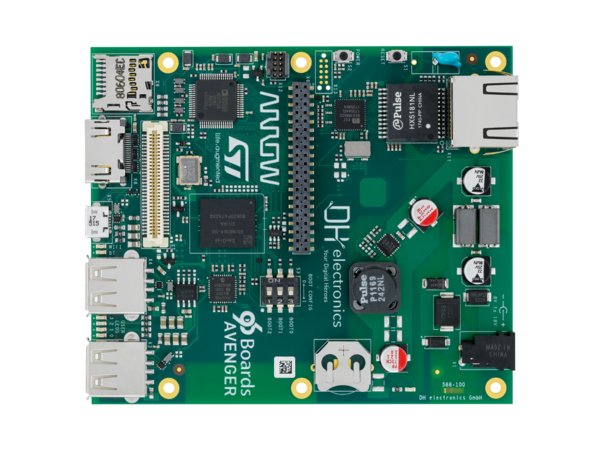Avenger96: Difference between revisions
From Wiki-DB
Jump to navigationJump to search
Ageisreiter (talk | contribs) |
Ageisreiter (talk | contribs) |
||
| Line 64: | Line 64: | ||
* [https://www.dropbox.com/s/f9jvcdq8rgb3e3f/DOC_Getting-Started-588-200_R03_2020-05-29.pdf?dl=1 Avenger96 588-200 Getting-Started R03] | * [https://www.dropbox.com/s/f9jvcdq8rgb3e3f/DOC_Getting-Started-588-200_R03_2020-05-29.pdf?dl=1 Avenger96 588-200 Getting-Started R03] | ||
* [https://www.dropbox.com/s/40k1tygmsiogy6r/USM_DHCOR-STM32MP1_R05_2019-12-12.pdf?dl=0 '''NEW''' DHCOR STM32MP1 User Manual R05 <span style="color:#FF0000">'''IMPORTANT: Please have a look at NEW chapter 24. Hardware design checklist'''</span> ] | * [https://www.dropbox.com/s/40k1tygmsiogy6r/USM_DHCOR-STM32MP1_R05_2019-12-12.pdf?dl=0 '''NEW''' DHCOR STM32MP1 User Manual R05 <span style="color:#FF0000">'''IMPORTANT: Please have a look at NEW chapter 24. Hardware design checklist'''</span> ] | ||
:'''NOTE''' Please also have a look at the STM32 MPU wiki: [[Avenger96#Links | Links]] | :'''NOTE:''' Please also have a look at the STM32 MPU wiki: [[Avenger96#Links | Links]] | ||
== Design Files == | == Design Files == | ||
Revision as of 14:12, 15 September 2020

|
Introduction
The AVENGER Board is a 96Boards compliant consumer edition board based on the STM32MP15 series of SoCs. The STM32MP15 series is a highly integrated multi-market applications processor designed to enable secure and portable applications within the Internet of Things. AVENGER board features Dual-core Arm® Cortex®-A7 processors operating at up to 650 MHz, Single core Arm® Cortex® M4 operating up to 209 MHz. In addition, an extensive set of interfaces and connectivity peripherals are included to interface to cameras, touch-screen displays, MMC/SD cards and media processor engine. It also fully supports wireless communication, including WLAN and BLE.
Technical Details
|
|
Documentation
- Avenger96 588-200 Getting-Started R03
- NEW DHCOR STM32MP1 User Manual R05 IMPORTANT: Please have a look at NEW chapter 24. Hardware design checklist
- NOTE: Please also have a look at the STM32 MPU wiki: Links
Design Files
- Avenger96 Schematic
- Avenger96 Bill of Material
- Avenger96 Assembly Top
- Avenger96 Assembly Bottom
- Avenger96 3D STEP file
- DHCOR STM32MP1 Allegro/Orcad schematic and layout symbols (release date: 16.10.2019) Now with Allegro *.brd file and 3D information
- DHCOR STM32MP1 3D STEP file
- Avenger96 CubeMX configuration (release date: 03.05.2019)
Software
DH Mainline based Linux
- Notes:
- - The Mainline based Linux offers Etnaviv GPU driver support!!!
- - Based on kernel 5.4.x and Yocto version dunfell
- NEW Yocto meta layer --> Github
- NEW DH Mainline based Starter Image
- NEW Linux and bootloader documentation
OpenSTLinux
- Notes:
- - GPU support based on original vivante GPU driver.
- - Based on kernel 4.19.x and Yocto version thud
- DH electronics Github contains the meta-av96 layer for ST v1.2.0 SDK. Please see readme.txt which describes the build process.
- X-LINUX-AI OpenSTLinux Expansion Package: Description: Expansion Package that targets artificial intelligence for STM32MP1 Series devices.
- NEW X-LINUX-AI OpenSTLinux Expansion Package
- NEW How to install X-LINUX-AI v2.0.0 on Avenger96 board